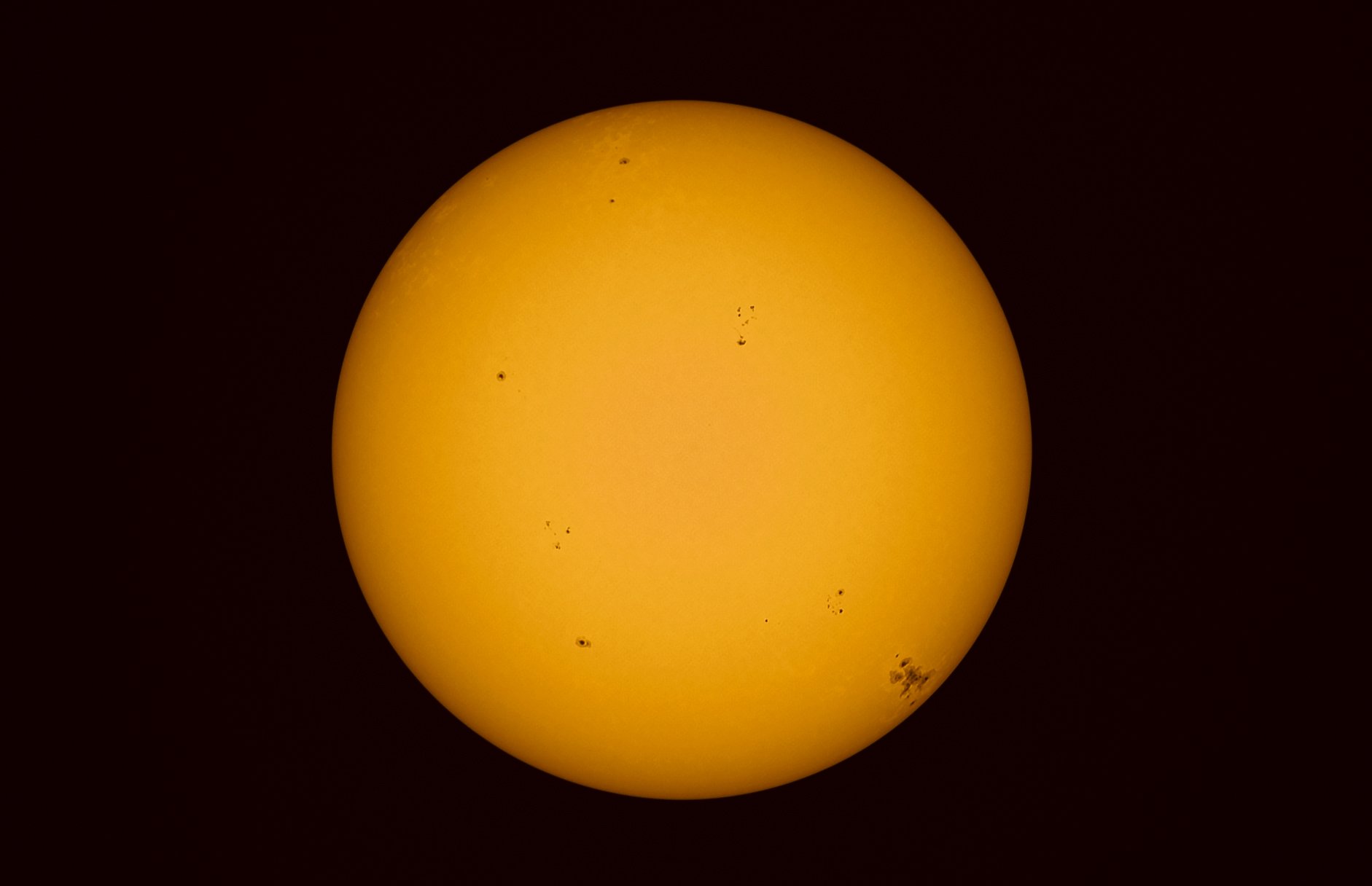A new tool for astrophotography enhancement
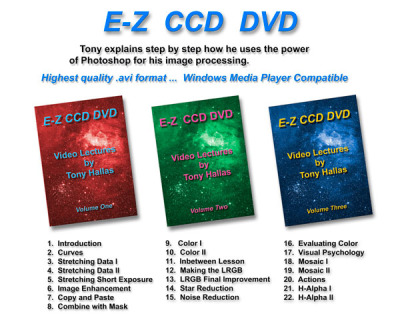 EZ CCD DVD by Tony Hallas is a new tool for the astrophotographer to improve their image enhancement skills. I just completed viewing the 3 DVD set and here are the answers to your questions:
EZ CCD DVD by Tony Hallas is a new tool for the astrophotographer to improve their image enhancement skills. I just completed viewing the 3 DVD set and here are the answers to your questions:
- Is it worth the $68? Yes. You have to remember, as much as I have studied Photoshop and processing, I still approach the subject as "unknowable." I always learn something from every course I digest. What I particularly like about this DVD series is that you are basically sitting at Tony's side as he works through M81 processing from post-reduction to final print. You work through stretching of luminance and application of RGB with the utmost attention to detail. This is the definition of Fine Art Photography.
- Will it make my images better? Yes. There were moments when I had the DVD running on my laptop with my M31 open in Photoshop and applied the current lesson to the image. The image was improved by at least 20% through these new approaches. In particular, application of the spunge and high pass filters were most useful for this image.
- Will I learn something? Yes. I have studied with many of the country's top landscape photographers and image enhancement and compositional consideration were a part of those instructions. I still learned many new techniques and more importantly how to apply them at my artistic taste.
- Who is this for? Are your frustrated with your image processing? Do you not know how to effectively use masks and filters to enhance selected parts of your image? Do you have a pretty good understanding of Photoshop, but want to go a bit deeper into the water? Then this DVD set is for you.
The DVDs contain video files of Tony lecturing during his workflow in addition to some lectures on color, visual psychology, mosaic construction, and hydrogen alpha enhancement. The DVDs are focused on enhancing 16 bit fit files converted to TIFF, which is a bit different from my current workflow with RAW converted DSLR images. So my stretching of TIFF data is a bit different than what Tony presents, but after the lecture on stretching, all other techniques are certainly viable for any astrophotographer regardless of how the data was captured.
I had to chuckle on his "green gun" technique as I recall when he introduced that to the old film astrophoto list many years ago. It is still a very viable technique and one that every astrophotographer should be aware of.
What I like most about Tony's presentation is that he is first and foremost an artist with a vision. You may or may not find his final art product to your liking, that is the nature of the beast, but what he does do is share with you what is possible and encourages you to explore those possibilities that match your own artistic voice. That is what is really important, developing your own artistic eye. While it is important to be keenly aware of the enhancement tools at your discretion, ultimately it is your ability as an artist to visually interpret the data and present it in a way that meets your artistic vision and pleases your intended audience.
That is exactly what I like to focus on when working with imagers, finding their own artistic vision and reconciling their work to meet that vision. If you find yourself not satisfied with your work, you know that something is just not right, give me a call and we can discuss some of the ways to find meet your vision through your image optimization approach.
You can purchase the DVD set directly from Tony here or from Astro-Physics here.
Sunrise Moon from West Summerland Key, FL
 Sunrise Moon from Florida keysAfter a spectacular night of astrophotography, I was treated to this intense display of light at sunrise. I was totally fatigued by the night's imaging, but this scene energized me so much that I had to work the scene. The Moon and rocks provided the necessary compositional elements to complete balance and a sense of scale to the image that is dominated by the intense horizon light. The Florida Keys offer many opportunities for amazing light and I hope to return often in order to capture those moments and bring them back to you.
Sunrise Moon from Florida keysAfter a spectacular night of astrophotography, I was treated to this intense display of light at sunrise. I was totally fatigued by the night's imaging, but this scene energized me so much that I had to work the scene. The Moon and rocks provided the necessary compositional elements to complete balance and a sense of scale to the image that is dominated by the intense horizon light. The Florida Keys offer many opportunities for amazing light and I hope to return often in order to capture those moments and bring them back to you.
The image is the first of the Florida collection and may be viewed in larger format by visiting that gallery. Many more images to come to the Florida gallery.
This image may be purchased by simply visiting the "Purchase Fine Art Prints" menu option, selecting your print size, and then typing "Sunrise Moon" as the image title of the print.
Venus Transit 2004 is now on the site
 Venus Transit June 2004One of my most coveted astronomical and landscape moments was in June 2004 when I photographed the unique transit of the Sun by Venus. A transit is where a planet moves in front of the solar disk creating a black dot shadow. These events certainly help put the size of the Sun into perspective. Venus can be seen in this image to the lower right quadrant.
Venus Transit June 2004One of my most coveted astronomical and landscape moments was in June 2004 when I photographed the unique transit of the Sun by Venus. A transit is where a planet moves in front of the solar disk creating a black dot shadow. These events certainly help put the size of the Sun into perspective. Venus can be seen in this image to the lower right quadrant.
A lot of preparation and planning went into the composition. My first objective was to capture the event in the landscape. This meant I had to utilize the natural filters available on Earth. One of these is the marine layer of the oceans. The Atlantic is closest to me and the transit was going to be timed perfectly to occur during sunrise in the eastern U.S. (For even more information on the event, please see my archived webpage detailing the event with site photos.)
The location selected was Myrtle Beach, mainly because I was familiar with the location and I knew the Sun would rise directly over the waters of the Atlantic. The only thing needed was a clear sky and boy did we get one. This is one of my favorite images and I hope you enjoy it, too. More details at the link below.
You may also purchase this print by simply navigating to the "Purchase Fine Art Prints" page and selecting print/mat size and inputing "Venus Transit" in the print title.
Candy for good little boys and girls...
Vendors at a star party provide the candy for the good little boys and girls. We all manage to find some reason why we need that beautiful new ????? for our next observing/photography session. It is always great to see the vendors goods live and in-person and WSP provides a great opportunity for one to do just that. Believe it or not, one could sign up for a loaner program from TeleVue where you could actually borrow the eyepiece for a two hour period and fully evaluate the eyepiece on YOUR scope. I bet they sold quite a few Ethos eyepieces through the loaner program. A great win-win program for all.
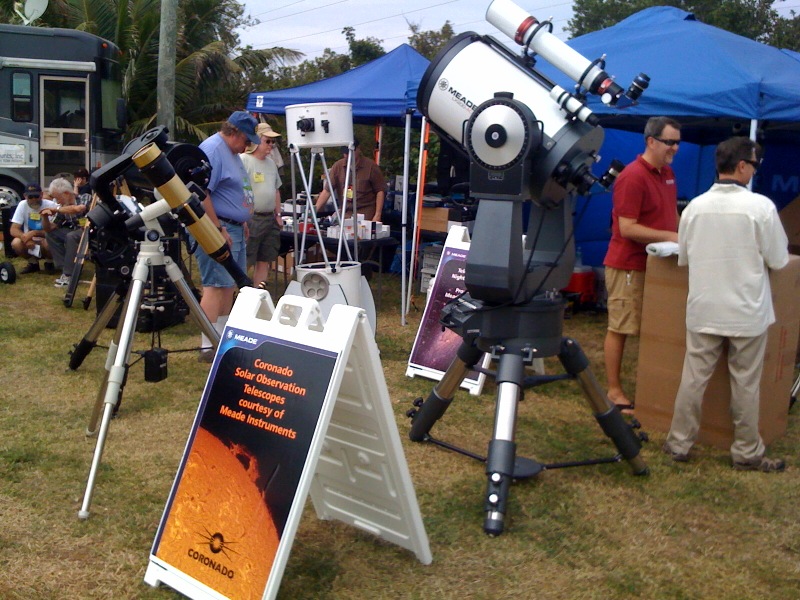 Meade Telescopes featuring a 16" SCT.The diversity of the group is quite substantial ranging from telescope manufacturers like Meade and Televue to t-shirt retailers and fine art painters. One can purchase a $20,000 telescope setup or a AA battery (thanks Astro-Gizmos!) I always learn about a new product or feature each time I visit a vendor. Prior to this WSP I knew little about ATIK cameras. After speaking with Warren Keller, I have a pretty good idea about their products and will likely purchase one of their cameras as an autoguider.
Meade Telescopes featuring a 16" SCT.The diversity of the group is quite substantial ranging from telescope manufacturers like Meade and Televue to t-shirt retailers and fine art painters. One can purchase a $20,000 telescope setup or a AA battery (thanks Astro-Gizmos!) I always learn about a new product or feature each time I visit a vendor. Prior to this WSP I knew little about ATIK cameras. After speaking with Warren Keller, I have a pretty good idea about their products and will likely purchase one of their cameras as an autoguider.
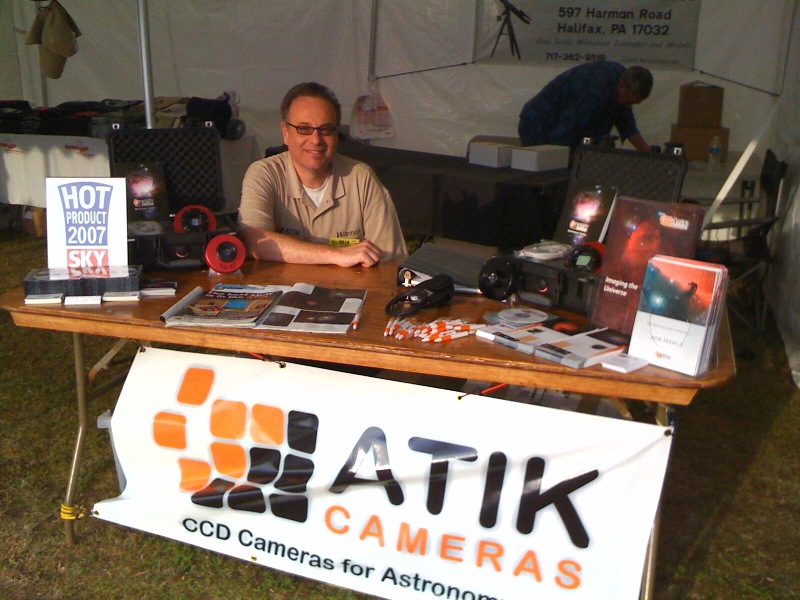 Warren Keller of ATIK CCD Cameras
Warren Keller of ATIK CCD Cameras
Meade offered views of the sun through their solar scopes which were quite enjoyable. They also had the monster 16" SCT in the photo above that was available for night sky viewing. Unfortunately, I did not have a chance to take in the night sky views through the 16". I spent some time with Jim from JMI discussing his motorized binocular telescope system. He had several sizes on hand including the 10" in the image below. I remember one of my first views through a home-made 10" binoscope a few years ago and the views were quite stunning. I had others share with me that the views through the binocular scopes were the equal of larger one-eyed scopes. These are instruments that serious visual observers should consider when purchasing a large scope.
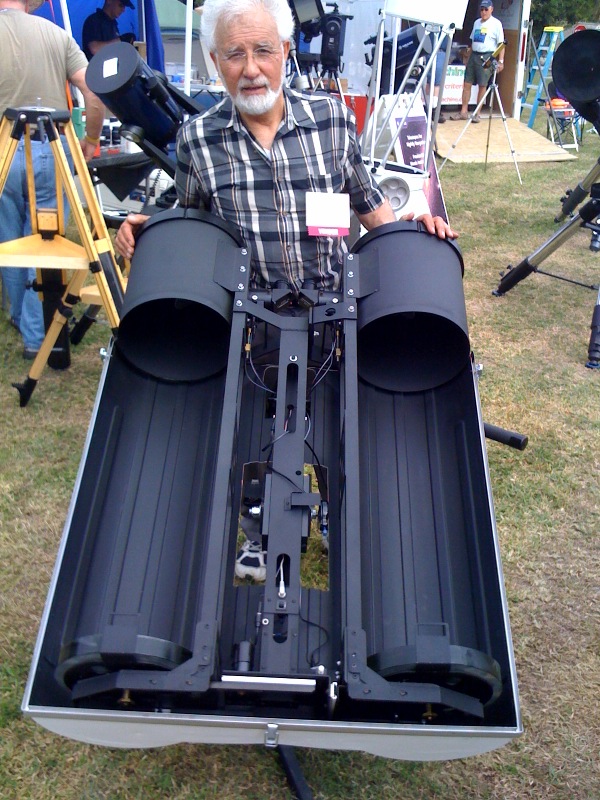 Jim of Jim's Mobile Instruments
Jim of Jim's Mobile Instruments
It was also nice to see the Disc Mounts in person again. Every time I see one of these I salivate a great deal. I can just envision one of my refractors on one of these mounts on a night of planetary observing bliss. But I just can't fit it into the budget right now...but I am waiting.
WSP provides a wonderful opportunity to see and test gear first hand. That is a rare opportunity, especially under such wonderful conditions as the steady Florida Keys skies. Definitely one of the great reasons to check out the Winter Star Party.
Solar viewing at it's best

The Wsp often affords the astronomer terrific views of the sun. Viewing the sun in high resolution requires very special filters and long focal length instruments.
Jim Sweeney had a wonderful solar viewing setup at wsp and was most gracious in sharing the views. High resolution views of the sun reveal intricate details on the surface as well as prominences that stretch out from the solar disk in wispy detail. These views were some of the finest, if not the finest, i have ever had.
Jim was viewing with a .2 angstrom solar sentinel model 3 filter. The more narrow the filter the more detail one can see on the sun. The ångström is often used in the natural sciences for expressing the sizes of atoms, lengths of chemical bonds and the wavelengths of electromagnetic radiation, and in technology for the dimensions of parts of integrated circuits. It is also It is my understanding that many of the most popular commercially available filters can only reach .4 angstroms.
The scope also needs to have a long focal length and large alerture. Jim uses a 7" astro-physics refractor with barlow lenses that effectively yield an f ratio of 22-25.
One of the best benefits in attending a star party is viewing through wonderful instruments that you would not normally get to view through Jim sweeney's solar viewing setup was fantastic and provided views of the sun unlike any I have seen.
Jeff's Blog
Join me on photography journeys from desert landscapes to deep sky wonders.










